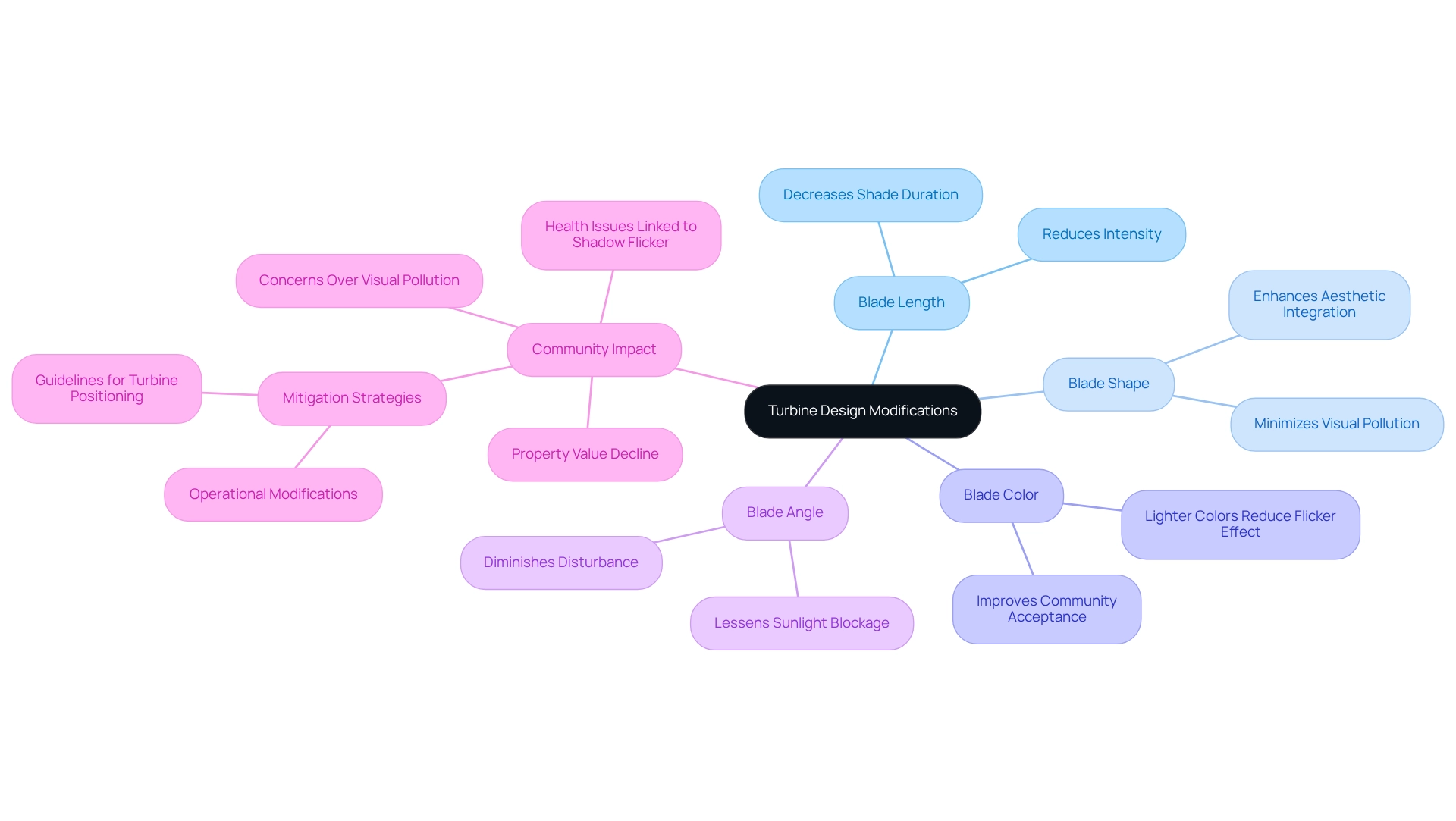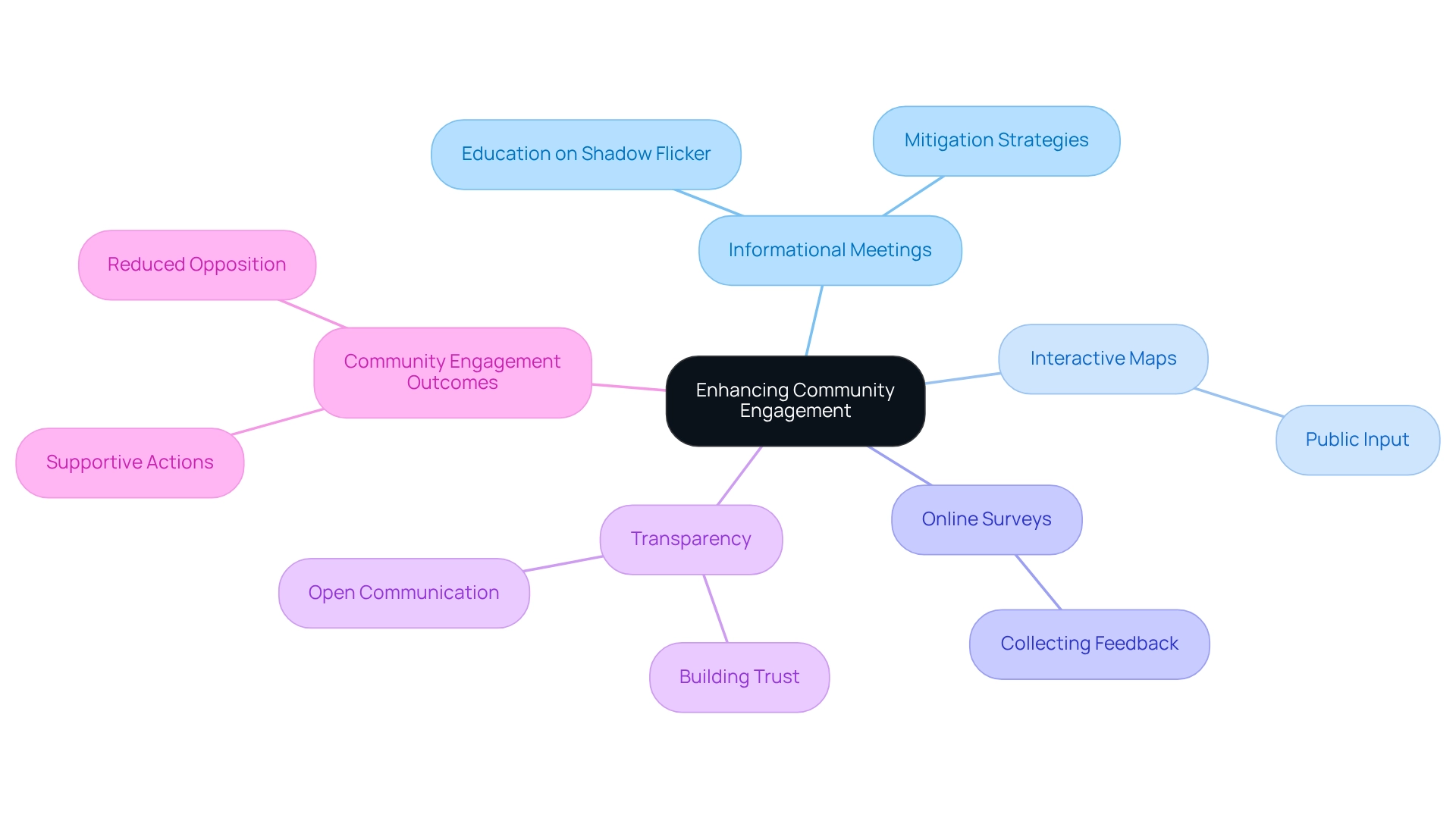Overview
Effective shadow flicker mitigation strategies for wind projects encompass:
- Turbine design modifications
- Optimized site layouts
- Advanced monitoring technologies
- Community engagement
- Compliance with local regulations
These strategies are essential in addressing the challenges posed by shadow flicker. Specific approaches, such as adjusting turbine blade characteristics and employing GIS mapping for strategic placement, are highlighted.
Collectively, these measures aim to reduce the negative impacts of shadow flicker on nearby residents, thereby enhancing project acceptance and fostering community support.
Introduction
In the quest for sustainable energy, wind power stands out as a leading solution. However, it is not without its challenges—most notably, the phenomenon of shadow flicker. This occurrence, where rotating turbine blades cast moving shadows, raises concerns among nearby residents, leading to issues such as visual pollution and potential health impacts. As the demand for wind energy continues to rise, the urgency to address these community concerns effectively becomes paramount.
To tackle the complexities surrounding shadow flicker, developers can implement:
- Strategic turbine design modifications
- Optimize site layouts
- Utilize advanced monitoring technologies
- Enhance community engagement
- Ensure compliance with local regulations
By adopting this comprehensive approach, the adverse effects of shadow flicker can be significantly mitigated.
Such measures not only foster a more harmonious relationship between wind projects and local communities but also pave the way for a more sustainable energy future. The time to act is now—developers must prioritize these strategies to secure community support and advance the wind energy agenda.
Implement Turbine Design Modifications
Altering turbine blade length, shape, and color is essential for decreasing the intensity and duration of shade fluctuation. Research suggests that lighter-colored blades can significantly reduce the visual effect of flickering silhouettes, making them less intrusive for nearby residents. Moreover, adjusting the angle of the blades can effectively lessen the sunlight they block, thus diminishing the disturbance on nearby properties.
A study on the impact of wind turbines on local communities highlighted that residents expressed concerns over visual pollution caused by shadowing effects, which has been linked to health issues and declining property values. The government report suggested shadow flicker mitigation strategies to address this effect, including guidelines for turbine positioning and operational modifications to lessen the duration of light fluctuations.
Current statistics reveal that in highly impacted zones, 8 to 13 turbines are often visible. This visibility can exacerbate the perception of shadow flicker, underscoring the importance of thoughtful turbine placement and design modifications in these areas.
Specialists advocate for location-sensitive planning to ensure that energy developments protect both ecological and human well-being. As Charles Hendry, the Energy Minister, stated, "It is essential that we utilize the most current, strong and precise scientific evidence when examining the effect of farms on communities." By implementing these design changes during the planning phase, wind projects can become more community-friendly and sustainable.

Optimize Wind Farm Site Layout
To effectively mitigate the impacts of light interference, implementing shadow flicker mitigation strategies is essential. This involves strategically positioning turbines away from residential areas and ensuring adequate spacing between them. Research indicates that maintaining a distance of at least 1,500 feet from residences can significantly reduce light variation exposure, keeping it within acceptable limits—typically defined as no more than 30 hours per year. Notably, studies reveal that in highly impacted zones, 8 to 13 turbines can be visible, highlighting the critical nature of careful turbine placement.
Advanced GIS mapping tools are instrumental in this process, enabling developers to simulate various shading scenarios and optimize turbine placements accordingly. For instance, a study examining light environmental impacts from offshore wind farms in South Korea analyzed diverse landscapes—rural, urban, and island—emphasizing the necessity of location-sensitive planning. It found that optimized turbine placement, coupled with green buffers and zoning regulations, effectively minimized adverse effects in urban areas, particularly in tourist zones.
By leveraging these GIS tools, developers can enhance site layouts to not only reduce shading effects but also improve overall project sustainability. As a practical recommendation, developers should utilize GIS mapping during the planning stage to assess potential light interference effects, ensuring that turbine locations are optimized with shadow flicker mitigation strategies to minimize disruption to neighboring communities.
Utilize Advanced Monitoring Technologies
Advanced monitoring technologies, particularly the Vestas Shadow Control System, play a crucial role in implementing shadow flicker mitigation strategies for managing shadow effects in wind projects. These systems are designed to consistently monitor sunlight conditions and turbine locations, allowing for real-time adjustments that minimize disturbances for nearby residents. Notably, the Vestas system can automatically pause turbine operations during peak fluctuation periods, effectively preventing disruptions. This proactive approach not only alleviates potential concerns but also demonstrates a commitment to societal well-being, fostering positive relationships with local stakeholders.
Research indicates that when executed effectively, shadow flicker mitigation strategies significantly reduce the incidence of indistinct light fluctuations, thereby enhancing the overall acceptance of energy projects. For instance, a case study examining the efficacy of advanced monitoring technologies revealed that energy farms utilizing such systems experienced a notable decrease in complaints from residents regarding light disturbances. Furthermore, scientific consensus suggests that when managed appropriately, shadow flicker does not negatively impact health, reinforcing the notion that these technologies can mitigate local concerns. By prioritizing these innovative solutions, turbine farm operators can ensure compliance with regulations while promoting sustainable energy practices.
As Francis Beinecke stated, 'Wind and other clean, renewable energy will help end our reliance on fossil fuels and combat the severe threat that climate change poses to humans and wildlife alike.' This underscores the broader ecological benefits of energy initiatives, further enhancing local acceptance.
Enhance Community Engagement and Communication
Proactive public involvement from the outset of a wind project is vital for its success. Developers must organize informational meetings to educate the public about shadow flicker impacts, including discussions on mitigation strategies, while ensuring that clear and accessible documentation is provided. Tools such as interactive maps and online surveys can significantly enhance public input, allowing residents to voice their concerns and recommendations. This approach not only fosters a sense of involvement but also enhances transparency, which is essential for building trust.
Research indicates that encouraging local efforts, such as attending meetings, is more common than opposing actions, reflecting a generally positive attitude towards energy initiatives. A recent study classified public responses to energy initiatives, demonstrating that supportive actions were considerably more prevalent than opposing ones, with meeting attendance being the most common form of engagement. Moreover, the typical planning and permitting process for wind projects can exceed five years in certain nations, underscoring the significance of early public involvement to accelerate project timelines.
As Jose Zayas, formerly with the DOE, emphasized, "This work was financed by the Wind Energy Technologies Office within the Office of Energy Efficiency and Renewable Energy of the DOE," highlighting the essential role of public involvement in fostering acceptance. By addressing concerns openly and incorporating community feedback, developers can significantly reduce opposition and promote social acceptance of their projects. This is particularly important given the regional variations in acceptance factors that necessitate tailored engagement strategies.

Ensure Compliance with Local Regulations
Developers must possess a comprehensive understanding of local regulations governing light interference limits, which are typically capped at 30 hours per year. Compliance with these regulations is paramount; failure to adhere can result in project delays or outright denials. Conducting detailed assessments during the planning phase is essential to ensure compliance and mitigate potential disputes. Utilizing sophisticated software for modeling light variations not only demonstrates compliance with these regulations but also streamlines the approval process.
For instance, Apex Clean Energy's proposed Goose Creek Wind Project is currently under review by the zoning board, which is evaluating regulations related to shade movement, setbacks, and noise limits. As Ryan Haac from RSG emphasizes, "Developers and local elected officials aiming to reduce light interference annoyance should not concentrate solely on projected exposure." This underscores the necessity for developers to proactively address compliance issues, facilitating smoother project approvals and avoiding complications during the permitting process.
Furthermore, with the maximum tower tip height approved at 625 feet, understanding the scale of turbine projects is critical for assessing their potential impact on shadow flicker mitigation strategies. The distributed wind capacity could cover more than half of the nation's current annual electricity consumption, highlighting the significance of compliance in maximizing project benefits.
Conclusion
Addressing the challenges of shadow flicker is crucial for the sustainable growth of wind energy projects. Strategic turbine design modifications can significantly reduce the visual impact of flickering shadows, alleviating concerns from local residents. By optimizing site layouts through careful turbine placement and maintaining adequate distances from homes, exposure is further minimized, ensuring that communities can coexist harmoniously with renewable energy initiatives.
Advanced monitoring technologies, such as the Vestas Shadow Flicker Control System, provide innovative solutions to manage flicker effects in real-time, demonstrating a commitment to community well-being. Equally vital is proactive community engagement, which fosters transparency and trust, allowing residents to voice their concerns and contribute to project planning. Prioritizing open communication enables developers to cultivate a supportive atmosphere around wind energy projects.
Strict adherence to local regulations is essential to avoid project delays and ensure compliance with shadow flicker limits. By combining strategies—design improvements, site optimization, technological advancements, community involvement, and regulatory compliance—developers can mitigate the adverse effects of shadow flicker and pave the way for a more sustainable energy future. The time to act is now; embracing these measures will secure community support and drive the wind energy agenda forward, ultimately benefiting both the environment and local populations.
Frequently Asked Questions
Why is altering turbine blade length, shape, and color important?
Altering turbine blade length, shape, and color is essential for decreasing the intensity and duration of shade fluctuation, which can reduce the visual effect of flickering silhouettes and make them less intrusive for nearby residents.
How can the angle of the turbine blades affect sunlight blocking?
Adjusting the angle of the blades can effectively lessen the amount of sunlight they block, thereby diminishing the disturbance on nearby properties.
What concerns do residents have regarding wind turbines?
Residents have expressed concerns over visual pollution caused by shadowing effects from wind turbines, which have been linked to health issues and declining property values.
What strategies are suggested to mitigate shadow flicker effects?
Suggested strategies include guidelines for turbine positioning and operational modifications to lessen the duration of light fluctuations, ensuring turbines are positioned away from residential areas and adequately spaced.
What is the recommended distance for turbine placement from residences to minimize light variation exposure?
Research indicates that maintaining a distance of at least 1,500 feet from residences can significantly reduce light variation exposure, keeping it within acceptable limits of no more than 30 hours per year.
How many turbines are typically visible in highly impacted zones?
In highly impacted zones, it is common for 8 to 13 turbines to be visible, which can exacerbate the perception of shadow flicker.
What tools can help optimize turbine placement?
Advanced GIS mapping tools are instrumental in simulating various shading scenarios and optimizing turbine placements to minimize light interference.
What benefits can location-sensitive planning provide for wind energy developments?
Location-sensitive planning can protect both ecological and human well-being by ensuring that energy developments are designed to minimize adverse effects, particularly in urban areas and tourist zones.
What is the role of GIS mapping in the planning stage of wind projects?
GIS mapping helps developers assess potential light interference effects and optimize turbine locations with shadow flicker mitigation strategies to minimize disruption to neighboring communities.




